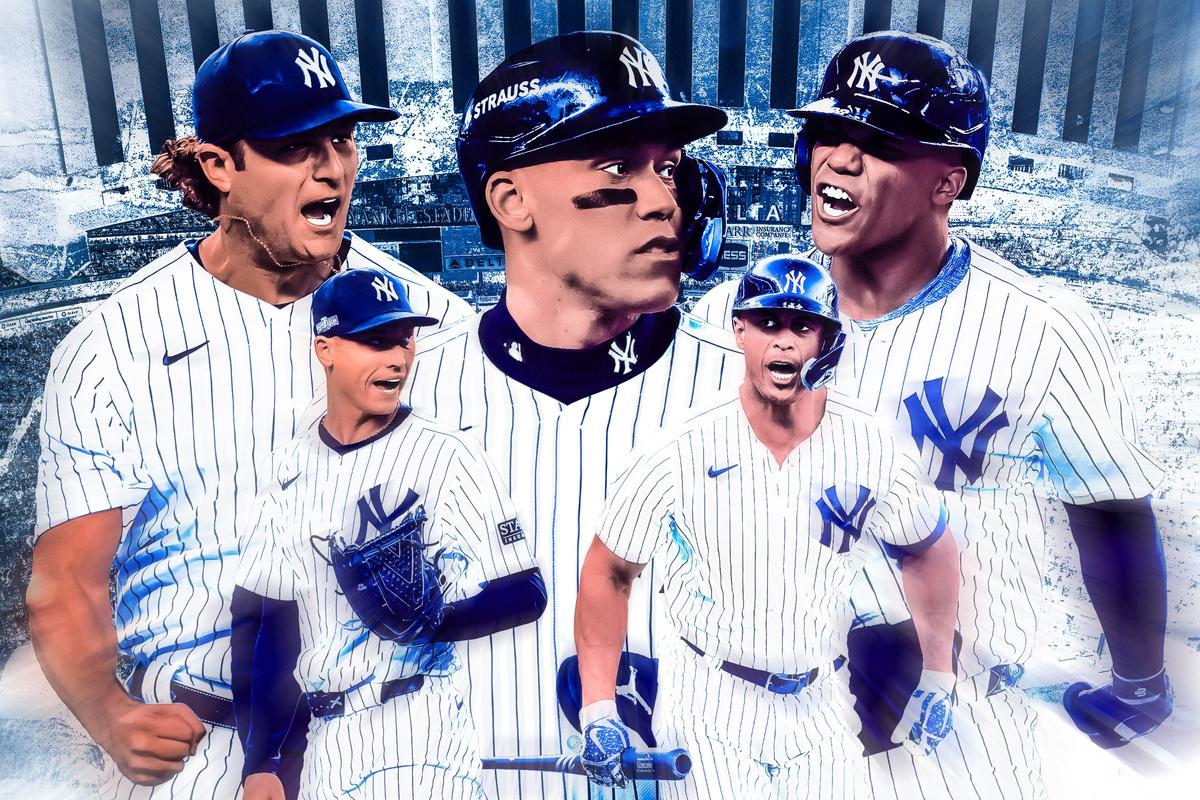
A man is at the plate. He was closer to a boy when he first started doing this sort of thing on national television, but he is a man now, in form, focus, and faculties. Top of the 10th, tied at two, on the road in Cleveland, Juan Soto is a win away from sending his New York Yankees to their 41st World Series. He lives for the tightrope, has both the nerve to call himself something as subtle as “Generational” and the moxy to remind you over and over again why the immodest shoe fits.
He’s a ballplayer but really a dancer. Merengue, bachata, dembow. The best clean lefty since Pittsburgh-era Barry Bonds, and before that Teddy Ballgame. He was raised in a tin-roofed and pavemented neighborhood of a city built over sand, sugar refineries, palm leaves, and the petrified wreckage of conquistadors. Shuffled his way through the minors and promptly to the bigs.
The at-bat’s a dance too: back and forth, give and take. A steady drip of head nods and lip gnawing. On offerings any distance outside the strike zone, Soto’s wont to do a jaunty shuffle. (There’s a song about it). He hacks off a bundle of breaking balls into foul territory—grandstands, fencing, the clay around home plate. His greatest gift is making the improbable look routine. Like a ballad in motion.

Mid-flight, pitch number seven, a fastball, finally, drifts toward the heart of the plate. Soto processes and anticipates this at quantum speed. By the time the hit that will send New York to its first fall classic in 15 years starts gliding off into the Midwestern moonlight, there are opposing fans in camera view, burrowing heads into palms. Mr. Generational’s chin is already raised plenty high.
When the wise man once asked how anyone could “not be romantic about baseball,” he was talking about these moments. Maybe not this team by name, no, but teams like this. Hold your rejoinders. Your well-earned distaste of the thieving Yankee Empire. Squad’s got a whole menu. A subplot extravaganza.
No appetite for the impacts of impending super-contracts? How about the greatest right-handed regular season in the history of a one-and-a-half-century game, vacillating daily between underwhelming and overwhelming under the brightest lights? Or a closer drafted as a starter a decade ago, bouncing between minor league outposts and big league waiver wires, until he starts repeating the same pitching motion and strutting around like some armored heel in a coliseum? Any interest in a future Hall of Fame starter trying to sling his way to a first title with an elbow swaddled in bubble wrap? An oversized Bronx persona non grata slugging like the Great Bambino himself?

What are we to call this highly paid, flummoxing, magnificent, cleanly shaven bunch? Not seamless. Too easy. Not soulless. Too hard. Block out the uniforms. Let the vibes wash over you. What do all 26 of them form combined together? What is a Yankee? What are these Yankees?
Twenty-seven rings are loud. They do the talking. They do the telling. Can’t converse with all that pinstriped clatter in the background. Can’t get to know ’em. Can’t trace their uncertainty. Their normal, competitively flawed, humanity. Oh but these brothers are something different. These Yankees. They aren’t the best Yankees or the most talented Yankees or the Yankee-ist Yankees, but they are the rarest kind of Yankee: ones that exist in the eye of the beholder.
They’re a little confounding. A little thrilling. A little messy. If you haven’t seen it, you will, on the biggest stage: their beauty marks and blemishes and, in the end, which badge matters more. In Yankees-Dodgers: The Reboot, a World Series billed as a clash of titans, the guys from out east might well be something else.
These ’24 Yanks are, certainly, pretty damn good. You don’t win a pennant otherwise. Last year, they weren’t. Last year, they kinda stunk. Head to the stadium with a smile and flee via the 4-train with an empty chicken bucket and beaucoup buyer’s remorse kinda energy. In hindsight this description was incomplete, if not a little unfair. The bones of bygone and impending behemoths were still there.
Yankees backpage patron saint Joel Sherman recently styled this year’s pennant in the Post as the “convergence” of all the team’s various strengths—from talent acquisition to player development and top-to-bottom organizational philosophizing. This is fair. Some of these components were always present, even in the occasional nadirs that have filled this 15-year drought.
The Bombers are, and have been, as skilled as any team at identifying and maximizing arms on the margin, in the starting rotation and the bullpen. Minor trade throw-ins and waiver-wire pickups arrive in the Bronx and are remade, if not reborn. Their postseason roster is littered with these ameliorated misfits: hurlers like Luke Weaver, Clay Holmes, Jake Cousins, Tim Hill, Luis Gil, and (the now injured) Ian Hamilton. The team meets them where they are. Takes their best pitch and tells them to throw it. Refines their delivery. Ups their spin rate.
Even in defeat, the front office apparatus has long functioned through consensus building and patience, to stave off groupthink. Yankees senior VP and general manager Brian Cashman is many things, but he’s never been the type to run a one-man show. He’s not afraid of bringing back old voices into the organization or overseeing an influx of new ones. When Cashman ranted to reporters at last year’s GM meetings in Scottsdale, by calling the New York front office “pretty fucking good,” this was part of the unspoken subtext: He wasn’t solely defending himself—he was defending an entire collective. They were never going to win in just one way. Nobody does anymore.
For years, New York struggled repeatedly to capitalize on their first-round draft selections—a weakness that stopped them from balancing an increasingly veteran roster with high-impact, cost-controlled youngsters. Today’s team wouldn’t have been able to endure the regular-season marathon without former first-rounders at catcher and shortstop and another in the starting rotation (to say nothing of a certain 6-foot-7 former first-round captain). But the margins didn’t have to be so thin.
Sometimes a coupon is a coupon for a reason. Sometimes you don’t have to win like everyone else. It took falling flat on their faces last year before the team was willing to go all in on an inner-circle Hall of Fame hitter without the benefit of a discount. In 2017 New York acquired Giancarlo Stanton with the help of a $30 million Marlins subsidy. Two years later, they wouldn’t sign then-free-agent outfielder Bryce Harper, even as he offered to move to first base, a position of need—a transition he’s since made seamlessly for the Phillies. While other teams scooped up one after another member of two historic free-agent shortstop classes, the Yanks remained wedded to their incoming prospects at the position. Last year’s injury-marred, mediocre output convinced them to up their ante in the Soto trade talks with San Diego.

The dividends have been apparent since Opening Day. The squad jumped out to the best record in baseball through late May, endured a couple of dog-day swoons, and steadied themselves leading into the fall. They had the top run differential in the AL (only nine runs behind the major-league-leading, National League–winning Los Angeles Dodgers) and posted the best record against teams above .500 in the entire sport. Over six months the Yanks rode two historic offensive seasons in combination with an elite starting staff to their first top seed in 12 years. And yet, even now, having won a pennant, the squad can’t quite kick the nagging reputation—placed onto them by opposing fans and even corners of the Yankee faithful—of a team that isn’t quite executing up to their results.
No, these aren’t the impeccable Yankees of old. In the stands, in both the ALDS and ALCS, murmurs ruing the team’s penchant for baserunning and fielding mistakes were as frequent as the use of “paesan” to describe the team’s two Anthonys. Resurrected Yankees play-by-play gawd John Sterling said they ran the bases “like a bunch of drunks,” on the airwaves last week, and—having witnessed it first-hand—the man spoke not one lie! There are often audible groans when certain players (Clay Holmes) walk out of the bullpen (Clay Holmes) or enter contests with men on base (Clay Holmes). This has transpired even as the team has lost a total of two games in their postseason run. New Yorkers are, true, a curmudgeonly bunch, but the phenomenon goes beyond simple regional orneriness, and, crucially, tends to erase Yankees excellence that isn’t as striking.
It is true, for instance, that the team has a few contributors with a habit for making the occasional glaring defensive error and, still, it is also true that as a unit this year’s Bombers are uncommonly gifted at run prevention. They have a lineup that has gone through periods of profound drought but they’re also highly effective overall. They didn’t have a closer until they did. They were slow on the base paths until they weren’t. But in each case, from multiple directions, it often seems like perceptions of the ‘24 Yankees haven’t quite caught up with their reality.
Or maybe those perceptions will prove to be right. The answer’s finally on deck. No disrespect to Bobby Witt Jr. or those four supposed horsemen in Cleveland but the Dodgers are a different, highly funded, pressure-tested opponent. We’re in for a rarity on multiple levels: the first series involving these teams since back when Reggie Jackson made an annual habit of shaking the upper deck of the House That Ruth Built like an express train—and also the first time the teams with the two best full regular-season records have met on this stage since 2013. (It also happened in the pandemic-shortened 2020 World Series between the Rays and Dodgers.) On Friday, in Chavez Ravine, five former MVPs and a handful of future Hall of Famers will occupy the dugouts. This series pits the second- and third-highest payrolls in the sport; a combined total of more than half a billion dollars. The two best players in baseball—men who grew up an ocean away from each other and put that same distance between them and their other competitors—both at their absolute peaks, both chasing after the phantoms of yesteryears.
If they can endure it, this pressure will make gems out of ballplayers. Legends will turn live action into fable. For a week or so a national pastime might damn well be resuscitated. Under these lights, folks can’t help but show their nature. There are reps, earnings, and custom jewelry on the table. Somebody’s leaving here with something.

